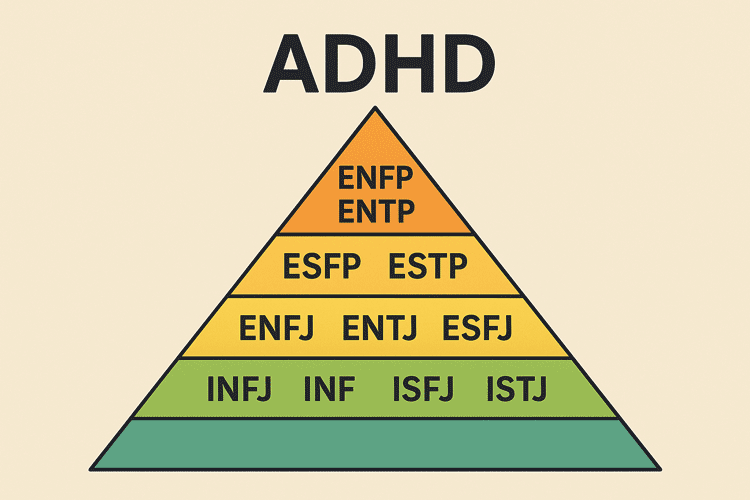Which MBTI Type is Most Likely to Have ADHD?
The central question “what mbti type is most likely to have adhd” is explored through psychology, personality research, and MBTI theory to understand which types may display traits overlapping with ADHD symptoms.
Introduction
Attention Deficit Hyperactivity Disorder (ADHD) is a widely studied neurodevelopmental condition that affects focus, impulsivity, and energy regulation. Meanwhile, the MBTI (Myers-Briggs Type Indicator) is a personality framework that helps people understand their preferences in thinking, decision-making, and social interactions. When combined, these two frameworks raise an intriguing question: what mbti type is most likely to have adhd?
Although ADHD is a medical diagnosis and MBTI is a personality assessment tool, comparing the two reveals interesting overlaps. This article provides an in-depth analysis of the MBTI types most associated with ADHD traits, supported by psychological research, expert insights, real-world case examples, and practical strategies.
What Is ADHD?
ADHD is characterized by three primary categories of symptoms:
Inattention: Difficulty focusing, easily distracted, struggles to complete tasks. Hyperactivity: Restlessness, fidgeting, difficulty staying still. Impulsivity: Acting without thinking, interrupting others, impatience.
ADHD Subtypes
Psychologists recognize three major presentations:
Predominantly Inattentive (ADHD-PI): Forgetfulness, zoning out, daydreaming. Predominantly Hyperactive-Impulsive (ADHD-PHI): Fidgeting, talking excessively, risk-taking. Combined Type (ADHD-C): A mixture of inattention and hyperactivity.
Global Prevalence
Children: 5–10% worldwide. Adults: 4–5%, though many remain undiagnosed. Gender differences: ADHD often looks different in women (more inattentive, less disruptive) versus men (more hyperactive, impulsive).
Understanding these distinctions is crucial when comparing ADHD with MBTI types.
What Is MBTI?
The MBTI categorizes people into 16 personality types based on four dimensions:
E (Extraversion) / I (Introversion) S (Sensing) / N (Intuition) T (Thinking) / F (Feeling) J (Judging) / P (Perceiving)
Among these, the Perceiving (P) preference is most linked to ADHD-like tendencies. Perceivers prefer flexibility and spontaneity over structure, mirroring ADHD traits like distractibility and impulsivity.
Key Question: What MBTI Type Is Most Likely to Have ADHD?
The keyword “what mbti type is most likely to have adhd” drives much online discussion. While ADHD and MBTI are not interchangeable, some types—especially Extraverted, Intuitive, Perceiving (ENP) types—tend to show behaviors that resemble ADHD more closely than others.
MBTI Types and ADHD Likelihood
1. ENFP – The Campaigner
ENFPs are imaginative, energetic, and people-focused.
ADHD Overlaps:
Struggle with deadlines and organization. Highly distractible but intensely focused on passions. Known for “idea hopping,” moving quickly from one interest to another.
This makes ENFPs one of the strongest answers to what mbti type is most likely to have adhd.
2. ENTP – The Debater
ENTPs thrive on curiosity and challenge.
ADHD Overlaps:
Constantly multitasking, often without finishing tasks. Impulsive decision-making. Highly energetic in conversations, sometimes overwhelming others.
Their restless, quick-thinking nature strongly resembles ADHD symptoms.
3. ESFP – The Performer
ESFPs bring energy and fun to every situation.
ADHD Overlaps:
Seek stimulation and variety. Impulsive spending or thrill-seeking. Difficulty with long-term planning.
Though not as strongly associated as ENFPs or ENTPs, ESFPs share ADHD’s hyperactive tendencies.
4. ESTP – The Dynamo
ESTPs are adventurous, spontaneous, and action-driven.
ADHD Overlaps:
Struggle with sitting still or handling repetitive work. Love risk-taking and immediate gratification. May act before thinking of consequences.
Their active lifestyle closely mirrors ADHD’s impulsive nature.
5. Other Potential Links
INFP: Though introverted, INFPs can appear inattentive, zoning out in daydreams. ENTJ: Rarely linked to ADHD, but when combined with ADHD, ENTJs may show impatience and overdrive. ISFP: Gentle but distractible, sometimes fitting inattentive ADHD.
This shows that any MBTI type can have ADHD, but some are more statistically associated.
Why Perceiving Types Show ADHD Traits
The P (Perceiving) trait is the strongest MBTI link to ADHD-like behavior. Compared to Judging (J) types, Perceivers often:
Avoid strict structure. Prefer spontaneity and adaptability. Are energized by change and variety.
Thus, ENFP, ENTP, ESFP, and ESTP consistently top discussions about what mbti type is most likely to have adhd.
Scientific Support and Data
Although MBTI is not a clinical tool, research suggests correlations:
Executive Dysfunction: A core ADHD trait overlaps with the spontaneous, flexible habits of Perceiving types. Novelty-Seeking: ADHD individuals score high in novelty-seeking, similar to Extraverts and SP/NP types. Brain Studies: Both ADHD brains and ENP personalities show heightened dopamine activity when exposed to new stimuli.
This scientific overlap reinforces the ENFP and ENTP connection.
Real-Life Observations
Case Study 1: An ENFP student diagnosed with ADHD excels in creative writing but struggles with math homework due to focus challenges. Case Study 2: An ENTP entrepreneur with ADHD starts multiple businesses but often requires a partner to handle details. Case Study 3: An ESFP performer with ADHD channels energy into music and stage presence, thriving under excitement.
These examples illustrate how ADHD traits can fuel both challenges and success depending on environment.
Misconceptions to Avoid
“All ENFPs have ADHD” – False. MBTI is not diagnostic. “ADHD is just a personality quirk” – False. ADHD is a medical condition. “Introverts can’t have ADHD” – False. ADHD can present differently in introverts (quiet inattention vs. external hyperactivity). “ADHD is always a disadvantage” – False. With support, ADHD can enhance creativity, adaptability, and innovation.
Practical Applications
Understanding what mbti type is most likely to have adhd can help in:
Workplace: Managers can allow flexibility, creative outlets, and task variety for ADHD-prone types. Education: Teachers can adapt lesson plans, offering movement breaks and creative projects. Personal Growth: Individuals can embrace ADHD strengths (creativity, energy) while learning coping strategies (time management tools).
Conclusion
The question “what mbti type is most likely to have adhd” does not have a medical answer, but psychological evidence and personality research strongly point to ENFPs and ENTPs as the closest matches, with ESFPs and ESTPs also showing overlapping traits.
While MBTI cannot diagnose ADHD, recognizing these overlaps provides insight into how personality and neurodiversity interact. With the right support, ADHD tendencies can transform into strengths—fueling creativity, innovation, and adaptability.
No. MBTI measures personality preferences, while ADHD is a neurological diagnosis.
Because they share traits like impulsivity, distractibility, and a craving for novelty—hallmarks of ADHD.
Yes. They may experience ADHD differently, often masking it with rigid structure or struggling with hidden procrastination.
Indirectly, yes. Knowing your MBTI type can guide coping strategies, work environments, and personal growth.



